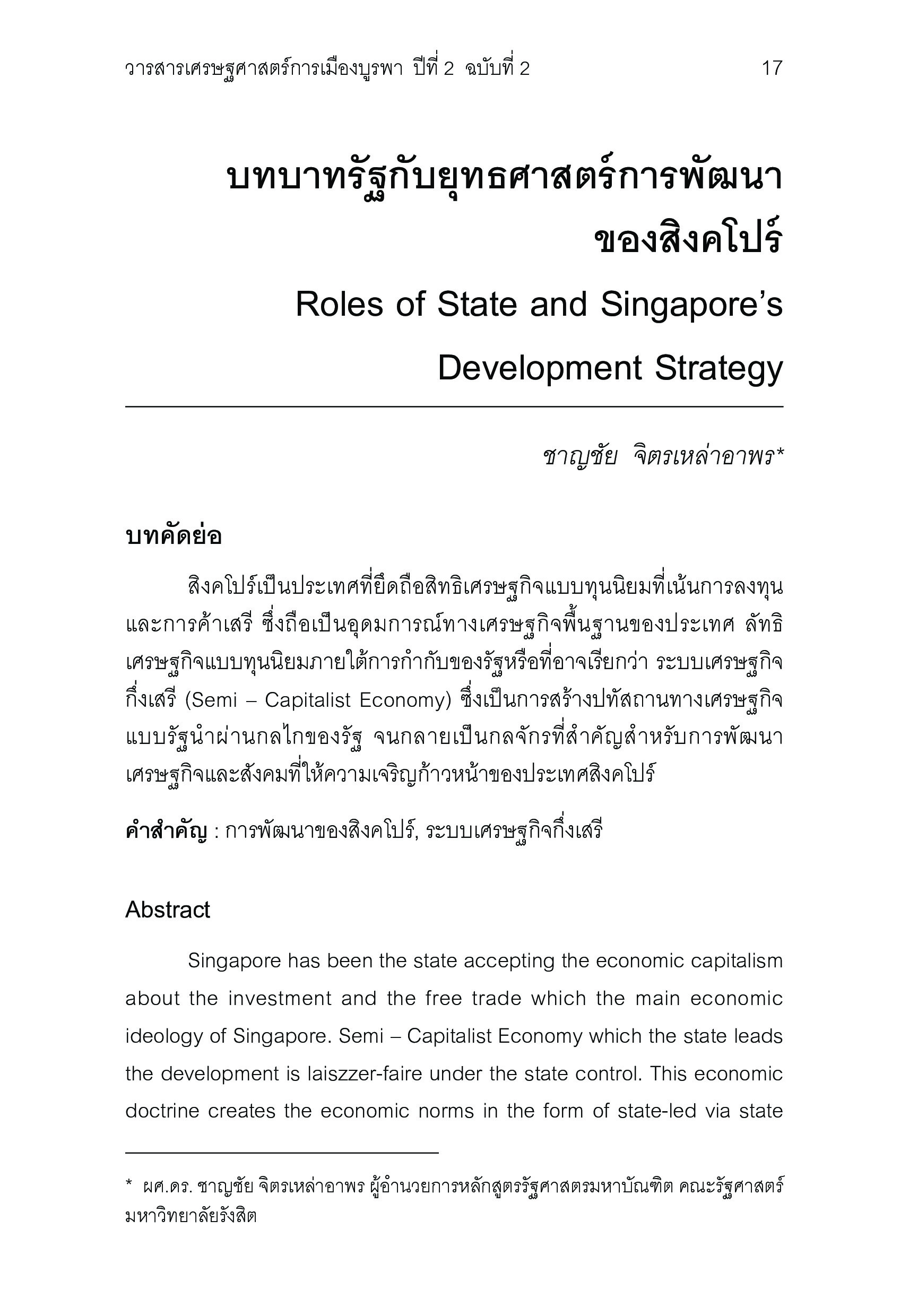Roles of State and Singapore’s Development Strategy
Keywords:
Singapore’s Development, Semi-Capitalist EconomyAbstract
Singapore has been the state accepting the economic capitalism about the investment and the free trade which the main economic ideology of Singapore. Semi – Capitalist Economy which the state leads the development is laiszzer-faire under the state control. This economic doctrine creates the economic norms in the form of state-led via state mechanism, that becomes the main factor for developing economy and society, and accentuates the progress of Singapore.
References
กระทรวงการต่างประเทศ. (2554). วันที่ค้นข้อมูล 12 มิถุนายน 2556, เข้าถึงได้จาก http://www.mfa.go.th/main/th/world/.
ปัญญาสิริ จรูญโกศล. (2557). รับมือ AEC ด้วยแนวทางของสิงคโปร์. กรุงเทพฯ: ต้นคิด.
วราภรณ์ จุลปานนท์. (2554). การเมืองในสิงคโปร์ (Politics in Singapore). กรุงเทพฯ: โรงพิมพ์มหาวิทยาลัยรามคำแหง.
วิวัฒน์ เอี่ยมไพรวัน. (2554). “การเมืองการปกครองของสาธารณรัฐสิงคโปร์”. ใน เอกสารประกอบการเรียนการสอน มหาวิทยาลัยสุโขทัยธรรมธิราช. นนทบุรี: โรงพิมพ์มหาวิทยาลัยสุโขทัยธรรมาธิราช.
สีดา สอนศรี และคณะ. (2552). เอเชียตะวันออกเฉียงใต้: การเมือง เศรษฐกิจและการต่างประเทศ หลังวิกฤตเศรษฐกิจ 2540-2550. กรุงเทพฯ: โรงพิมพ์แห่งจุฬาลงกรณ์มหาวิทยาลัย.
อภิวันทน์ อดุลยพิเชฏฐ์. (2556). ชุดอาเชียน “ในมิติประวัติศาสตร์ประวัติศาสตร์สิงค์โปร์”. กรุงเทพฯ: ด่านสุทธาการพิมพ์.
Barr, M. (2000). Lee Kuan Yew: the Beliefs Behind the Man. Surrey: Curzon.
Bello, W. & Rosenfeld, S. (1990). Dragons in Distress: Asian Miracle Economies in crisis. London: Penguin.
Bhaskaran, M. (2003). Reinventing the Asia Model: the Case of Singapore. Singapore: Eastern University Press.
Cato Institute. (2007). Economic Freedom of the World 2007. Washington DC: Cato Institute.
Ho, E. L. & Ee, C. Y. W. & Ramdas, K. (2013). Changing Landscape of Singapore: Old Tensions, New Discoveries. Singapore: NUS PRESS.
Junjia, Y. (2013). “Migrant Landscapes: A Spatial Analysis of South Asian Male Migrants in Singapore”. in Changing Landscape of Singapore: Old Tensions, New Discoveries. Singapore: NUS PRESS.
King, R. (2008). The Singapore Miracles, Myth and Reality. Western Australia: Insight Press.
Lee, K. Y. (2000). From Third World to First. Singapore: time Media.
Low, L. (1998). The Political Economy of a City State. Singapore: Oxford University Press.
Noorashikin, A. R. (2013). “Growing Old Singapore: Social Constructions of Old Age and the Landscapes of the Elderly”. in Changing Landscape of Singapore: Old Tensions, New Discoveries. Singapore: NUS PRESS.
Peebles, G. & Wilson, P. (2002). Economic Growth and Development in Singapore. Cheltenham: Edward Elgar Publishing.
Temasek Holdings (Private) Limited. (2014). Retrieved June 12, 2014, form http://www.temasek.com.sg/investorrelations/financialhighlights/groupfinancials.
Transparency International [TI] Report for 1998-2007. (n.d.). Retrieved June 12, 2014, form www.transparency.org.
Trewewan, C. (1994). The Political Economy of Social Control in Singapore. Britain: Macmillan.
Wright, M. (2006). Disposable Women and Other Myths of Global Capitalism. New York and London: Routledge.



